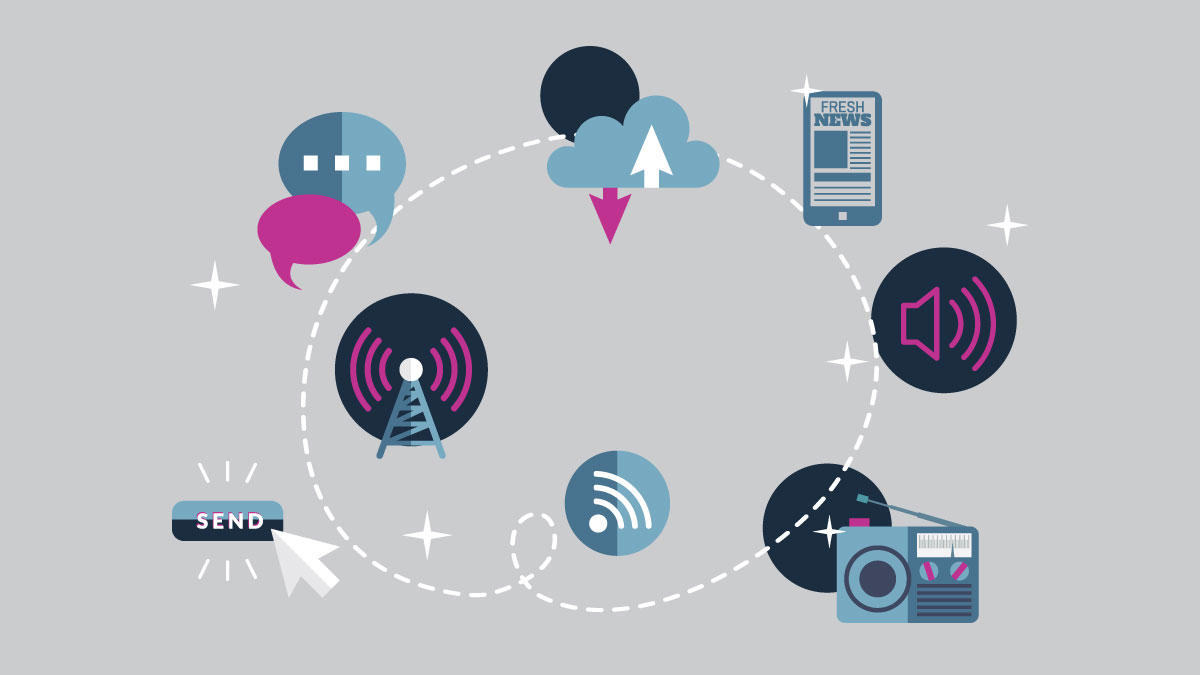Media Planning in a Multichannel World
Planning how to spend your advertising dollars is one of the biggest challenges a retail or service-based business has, whether you are a small, local business or a major, household name brand. There are so many ways to get your message in front of consumers and so many media sales reps making big promises and selling everything under the sun: newspaper, direct mail, radio, TV, billboards, online display ads, email lists, magazines, and more. With all of these options available, how do you know where to invest your budget? The fact that there are more and more ways every year to reach consumers (market fragmentation) makes selecting these tactics more difficult. Some veteran media buyers actually recall when you could reach an entire market with just a few ads across the three (and only three) TV networks.
In other words, media selection has gotten more complicated over time, and technology makes the ways and places to reach consumers seemingly endless.
The Zion & Zion media team, in an effort to communicate with clients the costs/benefits of various mediums, created an easy-to-follow visual on modern media strategy. This tool is called the Hierarchy of Media Investment Efficiencies. We call it, “HoMIE” for short.
The idea is this: media costs, engagement, and conversions all have a scale that can be counted from low to high. Conversions as a percentage are going to be much higher for someone searching for your brand name than for someone watching TV. It’s a much more qualified, engaged audience when a consumer is searching for your name or reading about your product category than if you reach a man watching a basketball game with an ad for a luxury vehicle after he recently bought a truck.
Here are the key elements of HoMIE:
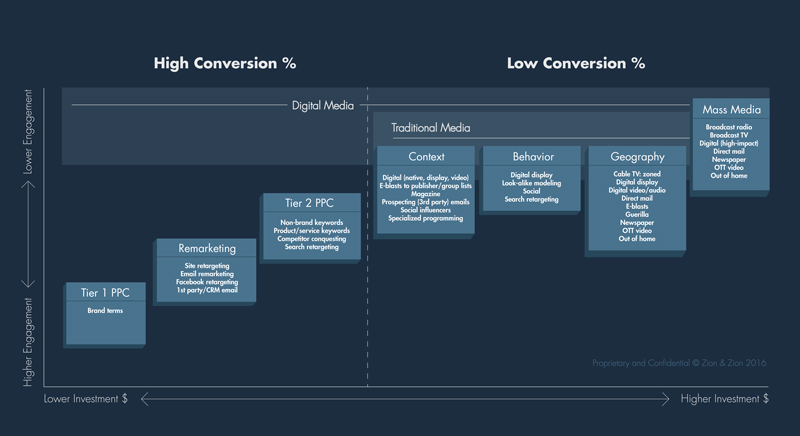
Branded Search
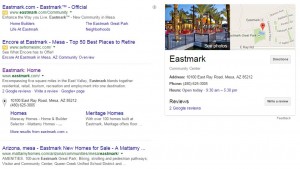
If someone is looking for you, help them find you. Branded search or /Pay-per-click advertising is the practice of paying for your own brand terms, even though you will likely end up in the organic listing, anyway. Paying for your brand terms can increase clicks and protects you from your competitors “conquesting” your brand terms. It can also elevate your brand by showing multiple results on the page leading to an increase in overall clicks. Simply put, multiple appearances will lead to incremental clicks.
It’s safe to assume that if a consumer is typing in your business name, they are ready to take some sort of action. They are either looking for your website, directions to your location, more information about your products or offerings, or they’re ready to buy online or set an appointment. Be there in every way possible. This is the foundation of HoMie.
Retargeting
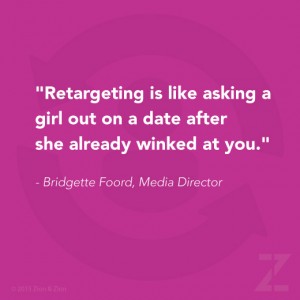
Retargeting is like asking a girl out on a date after she already winked at you. It’s fair to say that something about you caught her attention; you just need to make the next move. All marketing students are taught early on of the basic AIDA (attention, interest, desire, action) stages that a consumer experiences when exposed to advertising. Despite the fact that over the years it has been expanded on to add stages such as conviction, satisfaction, and reinforcement, the basic model holds true; and retargeting is an ideal way to pull a consumer through the interest stage into desire/action. It’s a way to add frequency and stay in front of hot prospects.
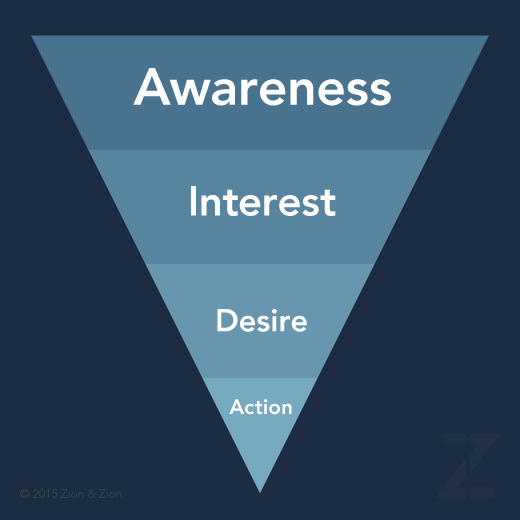
Product/Service Related Search
Sometimes consumers don’t know your name, or it’s not top of mind, but they are interested in your product category. This is where product or service-related search comes in.
They might be looking for “Restaurants in Phoenix” or “New Homes in Tempe” but if the search is applicable to you, you want your brand to become part of the selection set.
Also within this budget category would be competitor conquesting. You can’t stand outside the door of a competitor and hand out your own marketing materials, but you can do the online equivalent. You can pay to have your business appear in the paid search results when competing brand names are searched. It’s the marketing equivalent to inviting yourself to a party. You might get lucky and make a new friend.
Look-alike Targeting
Look-alike targeting takes an audience that you already know and targets a similar audience, with the goal of getting your ad in front of a person more likely to convert. There are many ways to define the audience you start with. They might be customers who have already converted on your website based on a pre-defined event (made a purchase, filled out a form for more information, downloaded a .pdf of your menu) or they might be your own customer database that has been reverse-profiled and segmented, but no matter what base you start with, the goal is to select key attributes and reach more of the same. In online marketing, complex algorithms and data providers lead us to these similar audiences. In offline marketing, the predictive models aren’t as sophisticated, but we might use PRISM or other lifestyle data to send a direct mail piece to these desired audiences.
Contextual Targeting
Contextual targeting refers to the vertical strategy of reaching a consumer in a relevant environment, and hopefully when they’re in the perfect mindset to receive your message. A carpet and flooring company would be in an ideal environment on HGTV/HGTV.com, in shelter or lifestyle publications, or next to a blog about the latest flooring trends. A Home Builder who advertises on home-search websites or puts display ads against editorial related to mortgages and school ratings will reach an active, in-market user. Use context and environment to prequalify your target audience.
Mass Media
Mass media includes any media selection with large cumulative reach, but generally has very few criteria available for targeting specific audiences. TV is usually the first thing people think of when they think about mass media advertising, likely because it’s highly visible and gets talked about the most. We marvel over and discuss the cost and content of :30 Super Bowl spots, but potentially nobody has ever gathered around the water cooler on a Monday morning to talk about the really cool banner ad they were served over the weekend. Mass reach media goes beyond TV, though. Billboards are actually a reach medium, used properly. For more on that, /check this out.
Also, Radio and print backed by enough budget are mass-reach mediums.
Although most advertisers often desire to make TV their first choice when advertising, it makes more sense to catch the low-hanging fruit through paid search and retargeting. Once you move up the hierarchy, you can add mass-reach media to start feeding the funnel.
Digital Display Advertising
What about digital display advertising, you ask? Display ads are the most versatile medium of all, and can plug into the hierarchy in a number of places, depending on the targeting and scale. They can run on desktop or mobile, include static visuals or video, be mass-reach or highly focused. Display ads are also one of the easiest tactics to plug into a media budget since they are sold on a cost per thousand basis, and you can adjust the spend accordingly, assuming you meet a publisher’s minimum spend requirements. Social media advertising and e-mail marketing are also flexible mediums that you can easily control the size and scale of the reach and spend level, and based on how you use them, can fit into HoMie in a variety of places.
Conclusion
HoMIE shows us how to put first things first. For the best cost per conversion, make your media investments where the costs are lower and engagement is higher, and then move up from there. As you move along the hierarchy, your audience reach will expand, but you will have your bases covered with your most likely converters, and that bigger, more massive audience will feed into every piece of the process.
